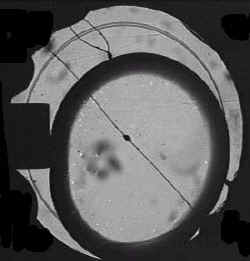The Pot Gets Hotter than the Stove

When you heat soup on the stove, you don’t expect it to get hotter than the burner because heat normally flows from hot regions to cold ones. But now, in the 1 May PRL, a team using an experiment on the Russian space station MIR has shown otherwise: For a fluid consisting of liquid and gas phases on the verge of a transition, the gas temperature can exceed that of its surrounding heat source, a condition known as local overheating. This counterintuitive effect was predicted theoretically a decade ago and demonstrates the complex nature of heat transfer in fluids.
For fluids confined to a fixed volume, such as a steel container, heat can be transferred inward in several ways: Warmer fluid can move into colder regions (convection), or the heat can conduct from hot to cold (thermal diffusion). Another heat transfer mechanism is “adiabatic compression,” also called the piston effect, where a hot, expanding outer layer acts like a piston and squeezes the interior of the fluid, heating it up. Near the liquid-gas critical point–a pressure and temperature where the two phases are indistinguishable–diffusion is limited, and in the absence of gravity, convection and other complicating effects are eliminated. So according to computer simulations, the piston effect should predominate if a near-critical fluid is warmed in space.
A French and American experiment on board MIR has now demonstrated the piston effect and the existence of local overheating. The team, led by Yves Garrabos and Regis Wunenburger of the University of Bordeaux I in Pessac, France, subjected a small cylinder of sulfur hexafluoride ( ) to periodic warmings. Looking something like the bubble chamber in a builder’s leveling tool, the cylinder contained a sulfur hexafluoride gas bubble surrounded by its liquid state, all maintained just below the critical temperature of 45.5 degrees C . The researchers recorded temperatures from both phases while the cell walls were heated in increments ranging from 20 to 100 mK.
During each small warming, or “quench,” the liquid remained cooler than the walls. But before the end of each quench the gas temperature passed up to 23% above that of the walls because of the piston effect. “The liquid surrounding the vapor squeezes and raises the temperature of the bubble faster than the heat can diffuse back out through the liquid,” explains Allen Wilkinson of the NASA Glenn Research Center in Cleveland. Because the gas bubble is isolated from the heat source (the cell wall), and because gas has a larger thermal response to a pressure change than a liquid, the gas bubble becomes an isolated hot region. The overheating doesn’t violate the laws of thermodynamics because the expanding liquid performs mechanical work; the phenomenon would be impossible in a purely diffusive system.
“This is very beautiful work by a well recognized team,” says Horst Meyer of Duke University. He calls the work “significant” for gaining a deeper understanding of phenomena such as boiling in fluids.
–David Appell
David Appell is a freelance science writer.


